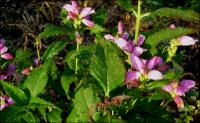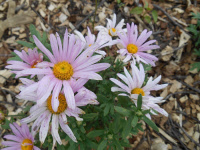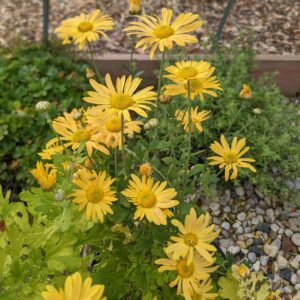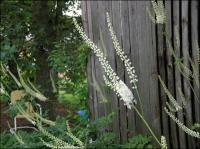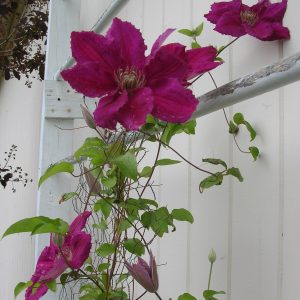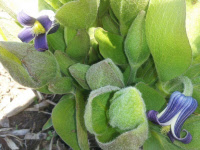Perennials & Biennials
Showing 113–120 of 511 results
-
Chelone obliqua Rose turtlehead Z 5-9
Showy rich rosy turtleheads top 2-3' stems from late summer into autumn.
Rich pink turtlehead shaped blooms in fall
Size: 16-24" x 12"
Care: Part shade moist to moist well-drained soil, tolerates clay
Native: Central and southeastern America
Wildlife Value: Attracts Baltimore Checkerspot butterflies.The name Chelone originated with French colonial settlers in Nova Scotia before 1700. They called this plant’s white-flowered relative (Chelone glabra) “La Tortue,” meaning “turtle” in French. This pink one found in 1752 by Virginia plantsman John Clayton and sent to John Bartram in Philadelphia in 1765. Called the “red Chelone.” A tea brewed from the leaves was said to increase appetite.
-
Chiastophyllum oppositifolium Syn. Umbilicus oppositifolius Lamb’s tail Z 5-9
For shady gardens, a low mound of thick, succulent green leaves, bearing arching, upright stems with dangling chains of sulphur yellow flowers in May-June.
OUT OF STOCK
For shady gardens, a low mound of thick, succulent green leaves, bearing arching, upright stems with dangling chains of sulphur yellow flowers in May-June.
Size: 6-8” x 10-12”
Care: part shade in moist to moist well-drained soil
Native: Caucasus Mountains
Awards: Recipient Royal Horticultural Society Award of Garden Merit1st described and named as Cotyledon oppostitfoilum in Bulletin scientifique (publié par l’) Académie Imperiale des Sciences de Saint-Pétersbourg 2: 813. 1837.
-
Chrysanthemum x rubellum ‘Clara Curtis’ Z 4-9
mid-summer through fall, sprays of large, single blush pink daisies
From mid-summer through fall, sprays of large, single blush pink daisies, each with a yellow eye.
Care: Sun to part shade in any soil. Pinch back half way early and again in late June to keep plants bushy and compact, or let them grow taller.One of the Korean hybrids. A. Cumming created this in 1937 by crossing an early flowering mum with Chrysanthemum coreanum.
-
Chrysanthemum x rubellum ‘Mary Stoker’ Z 4-9
Sprays of large, single warming yellow daisies, blushed with apricot top a bushy mound of light green leaves, Blooms late-summer to late-fall
OUT OF STOCK
Sprays of large, single warming yellow daisies, blushed with apricot top a bushy mound of light green leaves, blooms late-summer to late-fall
Size: 1-2’ x 2-3’ and spreading
Care: Full sun to part shade, tolerates normal, sandy or clay soil
Wildlife Value: Attracts bees, butterflies and birds. Deer resistant.One of the rubellum hybrids, Hybridized in the 1930’s
-
Cimicifuga racemosa syn. Actaea racemosa Snakeroot, Black Cohosh or Bugbane Z 3-8
Majestic milky white candles covered with buds like pearls that open to frilly balls in August
Majestic milky white candles covered with buds like pearls that open to frilly balls in August
Size: 4-6' x 2-4'
Care: sun to shade in any soil
Native: east N. America, Wisconsin native
Awards: England’s Royal Horticultural Society Award of Merit.Cimicifuga is from cimex (Latin) meaning bug and fugere meaning to drive away. The common name “bugbane” also refers to the plant’s odor which repels insects. The common name “cohosh” came from an Algonquin Indian word for rough referring to the feeling of the root. American Indians used its roots medicinally as an astringent, an antidote to poison and snakebites and to stop coughing. Roots infused in alcohol reduced pain from rheumatism (Cherokee.) Root considered an aphrodisiac, reputedly increased estrogen and reduced hot flashes. “Like most folk remedies, it was used to treat a wide variety of multiple complaints: bronchitis, cholera, fevers, nervous disorders, lumbago, rheumatism, snakebites. It was also used in childbirth and for menstrual irregularities.” Monticello.org Collected by John Bartram, c. 1750. Philip Miller (1768) reported this “deserves a place in the shady borders.” Thomas Jefferson listed this in his book Notes on the State of Virginia, 1787.
-
Clematis ‘Madame Julia Correvon,’ Z 4-9
Rich-red petal-like tepals 3-4” across bloom from June to September, encircling yellow stamens, on this vigorous, climbing vine
Rich-red petal-like tepals 3-4” across bloom from June to September, encircling yellow stamens, on this vigorous, climbing vine
Size: 12’ x 3-6’
Care: Sun to part shade in moist, well-drained soil. Cut back in early spring about 1’ above the soil level and just above a a pair of buds.
Wildlife Value: deer and rabbit resistant. Walnut tolerant. Attracts bees and butterflies.
Awards: Royal Horticultural Society Award of Garden MeritFrancisque Morel, Clematis breeder in Lyon France, grew this Clematis in 1900 from a cross of Clematis viticella ‘Rubra grandiflora’ and Clematis ‘Ville de Lyon,’ Named for the wife of the award-winning Geneva Switzerland nurseryman and author specializing in alpine plants, Henri Correvon (1855-1935). Nurseries at at 2 Chemin Dancet, 2 Plainpalais and Chêne-Bourg. Obituary https://www.nature.com/articles/144183b0.
-
Clematis ‘Ernest Markham’ Z 4-10
Big, bright magenta blooms June & repeat August – September, vigorous.
OUT OF STOCK
Big, bright magenta blooms June & repeat August – September, vigorous.
Size: 10-12’ x 2-3'
Care: Sun to part shade. Blooms on both old & new stems so cut back in early spring above healthy, big buds about 1' above ground.
Awards: Rated good by Chicago Botanical Garden Clematis evaluation.Hybrid c. 1930 by Ernest Markham (1881-1937) of England, head gardener at Gravetye Manor, home of William Robinson, father of mixed perennial borders.
-
Clematis fremontii Fremont’s leatherflower Z 4-7
Purple to white nodding bells with petal tips flipped up on this short perennial – not a vine
OUT OF STOCK
Purple to white nodding bells with petal tips flipped up on this short perennial – not a vine
Size: 12-18” x 12”
Care: sun to part shade in moist to moist well-drained soil
Native: Missouri, Kansas & Nebraska1st collected by John C. Fremont (1813-1890) celebrated American explorer, instigator of the “Bear Revolt” that made California independent from Mexico. Governor, then senator of California, owner of California gold mine, abolitionist (“free soil” Republican), leader of soldiers who massacred Native Americans, 1st candidate for president on the Republican ticket and Civil War general fired by Lincoln for freeing the slaves of Missouri. After accumulating fabulous wealth (gold mine) and spending it all, he died in poverty in New York. I call him the most interesting American you never heard of.

